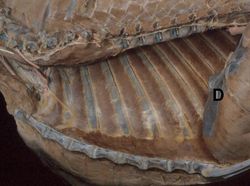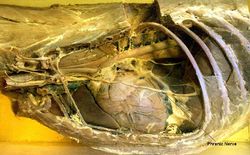Difference between revisions of "Diaphragm - Anatomy & Physiology"
| Line 1: | Line 1: | ||
| + | {{OpenPagesTop}} | ||
[[Image:DogThorax.jpg|right|thumb|250px|''Dog Thorax, contents of Thoracic Cavity removed. ©University of Nottingham 2008'']] | [[Image:DogThorax.jpg|right|thumb|250px|''Dog Thorax, contents of Thoracic Cavity removed. ©University of Nottingham 2008'']] | ||
| − | |||
==Introduction== | ==Introduction== | ||
| Line 33: | Line 33: | ||
{{citation|initiallast = Dyce|initialfirst = K.M|2last = Sack|2first = W.O|finallast = Wensing|finalfirst = C.J.G|year = 2002|title = Textbook of Veterinary Anatomy|ed =3rd|city = Philadelphia|pub = Saunders}} | {{citation|initiallast = Dyce|initialfirst = K.M|2last = Sack|2first = W.O|finallast = Wensing|finalfirst = C.J.G|year = 2002|title = Textbook of Veterinary Anatomy|ed =3rd|city = Philadelphia|pub = Saunders}} | ||
| + | {{OpenPages}} | ||
[[Category:Musculoskeletal System - Anatomy & Physiology]][[Category:Respiratory System - Anatomy & Physiology]] | [[Category:Musculoskeletal System - Anatomy & Physiology]][[Category:Respiratory System - Anatomy & Physiology]] | ||
[[Category:A&P Done]] | [[Category:A&P Done]] | ||
Revision as of 15:30, 28 June 2012
Introduction
The Diaphragm is a dome-shaped musculotendinous sheet separating the thoracic and abdominal cavities. It is convex on its cranial surface. In the neutral position between full inspiration and full expiration, the most cranial part of the diaphragm is in line with the 6th rib.
Structure
The muscular part of the diaphragm is peripheral, surrounding the central tendinous area. The muscular part has sections which arise from the xiphoid process of the sternum, vertebral column and caudal ribs.
Openings within the diaphragm
The diaphragm has three openings:
- Aortic Hiatus - the most dorsal opening, contains the aorta, azygous vein and thoracic duct
- Oesophageal Hiatus - contains the oesophagus, dorsal and ventral vagal trunks
- Caval Foramen - lies within the central tendinous region of the diaphragm and contains the caudal vena cava. This opening does not allow movement, the diaphragm is fused with the vessel wall.
Function
During inspiration, the diaphragm contracts to increase the volume of the thoracic cavity, decreasing its pressure, thus drawing air in. The diaphragm relaxes for expiration.
Innervation
The diaphragm is supplied by the phrenic nerve.
Species differences
Because of the shorter thorax, the diaphragm is steeper in the ruminant compared to the horse. Avian species do not possess a diaphragm. Air moves in and out of their lungs via air sacs.
References
Dyce, K.M., Sack, W.O. and Wensing, C.J.G. (2002) Textbook of Veterinary Anatomy. 3rd ed. Philadelphia: Saunders.
Error in widget FBRecommend: unable to write file /var/www/wikivet.net/extensions/Widgets/compiled_templates/wrt66326a97d9b9b0_83214761 Error in widget google+: unable to write file /var/www/wikivet.net/extensions/Widgets/compiled_templates/wrt66326a97dd4e18_46046057 Error in widget TwitterTweet: unable to write file /var/www/wikivet.net/extensions/Widgets/compiled_templates/wrt66326a97e06738_11748683
|
| WikiVet® Introduction - Help WikiVet - Report a Problem |

